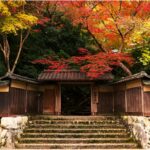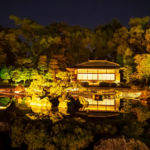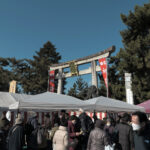Kyoto
Where is Kyoto?
Kyoto Prefecture is located on the island of Honshu, Japan, in the Kansai region. It’s nestled almost in the center of the main island, bordered by several other prefectures, including Osaka to the southwest and Shiga to the northeast. Historically, Kyoto City, within the prefecture, served as the imperial capital of Japan for over a thousand years. This rich history is reflected in the numerous temples, shrines, and traditional wooden houses preserved throughout the prefecture. The geography is diverse, ranging from mountainous regions in the north and east to flatter plains in the south and west. The Kamo River and the Katsura River flow through the prefecture, contributing to the scenic beauty. Kyoto Prefecture experiences distinct seasons, with hot, humid summers and cold, occasionally snowy winters. Public transport, including trains and buses, is readily available for travel within the prefecture and connecting to other major cities in Japan. When traveling to Kyoto Prefecture, you can expect to experience a unique intersection of ancient traditions and modern amenities.
What is Kyoto known for?
Kyoto Prefecture, located on Honshu Island, served as Japan’s imperial capital for over 1,000 years, from 794 to 1868. Originally named Heian-ky?, it was modeled after the ancient Chinese capital of Chang’an. During this period, Kyoto flourished as a center of culture, religion, and politics, shaping much of Japanese art, literature, and philosophy. While the capital moved to Tokyo, Kyoto retained its historical significance and avoided major damage during World War II. This preservation allows visitors to experience numerous well-maintained temples, shrines, and traditional wooden machiya houses. Kyoto is famous for its traditional crafts like Nishijin-ori textiles and Kiyomizu-yaki pottery. The city’s cuisine, featuring delicate flavors and seasonal ingredients, is another highlight. Gion, Kyoto’s geisha district, offers a glimpse into this unique cultural tradition. Its stunning natural beauty, particularly during cherry blossom and autumn leaf seasons, also attracts visitors worldwide.
Where should I visit in Kyoto?
Kyoto Prefecture offers a rich array of cultural and natural experiences. For those interested in history and temples, Kyoto City is a must-see. Key sites include: * **Kinkaku-ji (Golden Pavilion):** A stunning Zen Buddhist temple covered in gold leaf. * **Fushimi Inari-taisha Shrine:** Known for its thousands of vermilion torii gates winding up a mountainside. * **Kiyomizu-dera Temple:** A wooden temple with a large veranda offering panoramic city views. * **Ryoan-ji Temple:** Famous for its enigmatic rock garden. * **Arashiyama Bamboo Grove:** A picturesque path through towering bamboo stalks. Beyond the city, Kyoto Prefecture offers diverse landscapes and activities: * **Nijo Castle:** A UNESCO World Heritage site, showcasing Edo-era architecture and gardens. * **Gion District:** Kyoto’s geisha district, where you might catch a glimpse of geiko (Kyoto geisha) or maiko (apprentice geisha). * **Sagano Scenic Railway:** Offers scenic train rides through the Hozugawa River valley. * **Hozugawa River Boat Ride:** A traditional boat journey down the Hozugawa River. * **Byodo-in Temple (Uji):** A beautiful temple featured on the ten-yen coin, located in Uji, a city south of Kyoto known for green tea. * **Amanohashidate:** One of Japan’s three scenic views, a sandbar covered in pine trees. Located in northern Kyoto Prefecture. When planning your trip, consider these factors: * **Transportation:** Kyoto has a good public transportation system including buses and trains. Consider purchasing a Japan Rail Pass if you plan to travel extensively throughout Japan. * **Accommodation:** Kyoto offers a range of options from traditional ryokans (Japanese inns) to modern hotels. * **Food:** Kyoto is renowned for its cuisine, including kaiseki (multi-course Japanese haute cuisine), matcha (powdered green tea) sweets, and vegetarian Buddhist cuisine (shojin ryori). * **Seasonality:** Kyoto experiences distinct seasons. Spring (cherry blossom season) and autumn (fall foliage) are popular but can be crowded. Summer can be hot and humid, while winter can be cold. This list provides a starting point for exploring the diverse offerings of Kyoto Prefecture. Further research based on your interests will help you create a fulfilling itinerary.
When is the best time to visit Kyoto?
The best time to visit Kyoto Prefecture depends on your priorities. For comfortable temperatures and fewer crowds, spring (March-May) and autumn (September-November) are ideal. Spring offers cherry blossoms in full bloom, while autumn provides stunning foliage. Expect higher prices and more tourists during these peak seasons, particularly during the cherry blossom and autumn leaf viewing periods. Summer (June-August) is hot and humid with occasional rainfall, but offers festivals like the Gion Matsuri. If you prefer a quieter, more budget-friendly trip, consider winter (December-February). Temperatures can drop below freezing, with occasional snowfall, creating a unique atmosphere. Some temples and gardens might have limited hours during winter. Be aware that the rainy season typically occurs in June and July, and typhoon season runs from August to October, potentially affecting travel plans. Regardless of when you visit, booking accommodation and transport in advance, especially during peak periods, is highly recommended.
All Events in Kyoto
Rurikō-in Temple Autumn Opening
Kōdai-ji Zen Temple Autumn Illuminations
Nijō Autumn Harvest Festival
Tenjin-san Flea Market
Tenjin-san Flea Market
Tenjin-san Flea Market
Tenjin-san Flea Market
Tenjin-san Flea Market
Tenjin-san Flea Market
Tenjin-san Flea Market
Tenjin-san Flea Market
Tenjin-san Flea Market
Tours and Activities in Kyoto
None found.
Where should I stay in Kyoto?
Choosing the best place to stay in Kyoto Prefecture depends heavily on your interests and budget. Kyoto City itself offers a plethora of options, with Gion and Higashiyama districts being popular for their traditional charm and proximity to temples. For budget travelers, staying near Kyoto Station offers excellent transport links and affordable accommodations like the Piece Hostel Kyoto, known for its stylish design and social atmosphere. For a more luxurious experience, consider the Ritz-Carlton, Kyoto, situated along the Kamogawa River, offering impeccable service, exquisite dining, and stunning views. If you prefer a more tranquil escape, consider areas like Arashiyama, famed for its bamboo forest, or Ohara, nestled in the mountains north of the city. Arashiyama offers traditional Ryokans like Hanaikada, allowing guests to immerse themselves in Japanese culture. While staying within the city offers easy access to major attractions, venturing further afield provides a different perspective on Kyoto’s beauty and allows for exploration of charming towns and stunning natural landscapes. Ultimately, the best place to stay depends on your personal preferences and how you want to experience this captivating prefecture.
How do I get to Kyoto?
Kyoto Prefecture, located in central Honshu, Japan, is easily accessible by various means. The most convenient method for international travellers is flying into Kansai International Airport (KIX) near Osaka. From KIX, a direct JR Haruka express train reaches Kyoto Station in approximately 75 minutes. Alternatively, a more affordable option is the limited express train, taking around 90 minutes. For domestic travel, numerous bullet trains (shinkansen) connect Kyoto Station with major cities like Tokyo (2 hours 15 minutes), Osaka (15 minutes), and Nagoya (35 minutes). Highway buses provide another economical choice, with routes from various cities, though travel times are longer. Within Kyoto Prefecture, a comprehensive network of local trains, subways, and buses facilitates travel between cities and attractions. Consider purchasing an ICOCA card for convenient payment on public transportation. Taxi services are also available but can be expensive. Pre-booking transport, especially during peak season, is highly recommended.




